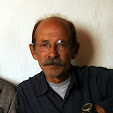In Iraqi Kurdistan there are many Yezidi temples, the most famous collection being at Lalish, the Yezidis' most venerated site. But because of the isolation of the Sinjar, the temples and shrines are the least known to the occasional contemporary visitor. Being less confident of my continued access to the region,
sooner has become more of an imperative, and so the journey continues.
 |
| Sheikh Abdul Qader Temple |
26 October 2012 - We jankle along the rutted tracks through the apron of low hills at the foot of Sinjar Mountain, looking for the Yezidi temple Sheikh Abdul Qader. Soon we see its squat spire gleaming white on the autumnal brown landscape, at once dramatic and humble, as we later find its keeper, Sheikh Mijo Seado Uso.
 |
| Sheikh Mijo Seado Uso |
I am once again in the Sinjar, called
Shangal locally, an isolated region in northwest Iraq, fully defined by the 60-mile long mountain of the same name. From space the mountain looks like the ridged back of an enormous science fiction creature emerging from the featureless Mesopotamian plains, heading due west to the nearby Syrian border. My goal is to visit more Yezidi temples and shrines –
mazar – that grace this traditional and sometimes forgotten heartland. (Please visit
"Yezidi Faqirs and Sheikhs in Sinjar", March 2012, and multiple other posts in this blog.)
 |
| Sheikh Ezid Temple |
Although many are flat-roofed, the Yezidi temples are generally known for their domed tops or conical spires, the latter often fluted. They commemorate both holy and historical persons, as well as angels from Yezidi cosmology, sometimes being one and the same. In the Sinjar they are most often found in the foothills, close to where the traditional villages were located before Saddam Hussein forced their abandonment; others are tucked deep in the mountain.
 |
| Sheikh Abu Bakir Shrine |
The shrines are much much smaller and often appear spontaneous with stacked rock walls. They denote natural features such as trees, rocks, caves, and springs that are sacred to the Yezidis. They too are given names like the temples. All mazar are the object of devotion and the destination of pilgrimage.
 |
| Sheikh Suliman Baxri Xider, mejewer |
Each temple has a keeper, or
mejewer, responsible for maintaining the temple, lighting the candles (wicks soaked in olive oil), and accepting the donations from visitors. It is a duty passed down through generations and often shared by members of the family. Usually, but not always,
mejewers are members of the sheikh class.
 |
| Sheikh Shems Temple interior |
The inner chamber of all temples is festooned with tangles of colorful silk cloth hanging from the walls. Upon entering shoeless, Yezidis tie knots into the cloth for good fortune, and untie knots of others thereby fulfilling the wishes of those who preceded them. Also common to the inner sanctums is a pillar in the center upon which the olive oil fires are lit, and round rocks are placed waiting to be stacked, again for good luck or the granting of wishes.
 |
| Sheikh Romi Temple |
Once again I owe my deepest of gratitude to my dear friend Sheikh Gharbi, without whom my visits to the Sinjar would be impossible.












This comment has been removed by the author.
ReplyDeleteYour blog was just linked to in a War Nerd article. I thought you might like to know:
ReplyDeletehttp://pando.com/2014/06/23/the-war-nerd-like-it-or-not-whats-happening-in-iraq-right-now-is-part-of-a-rational-process/